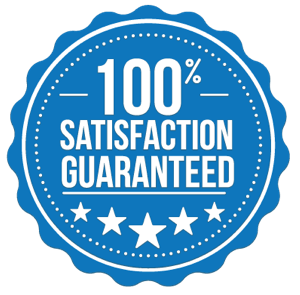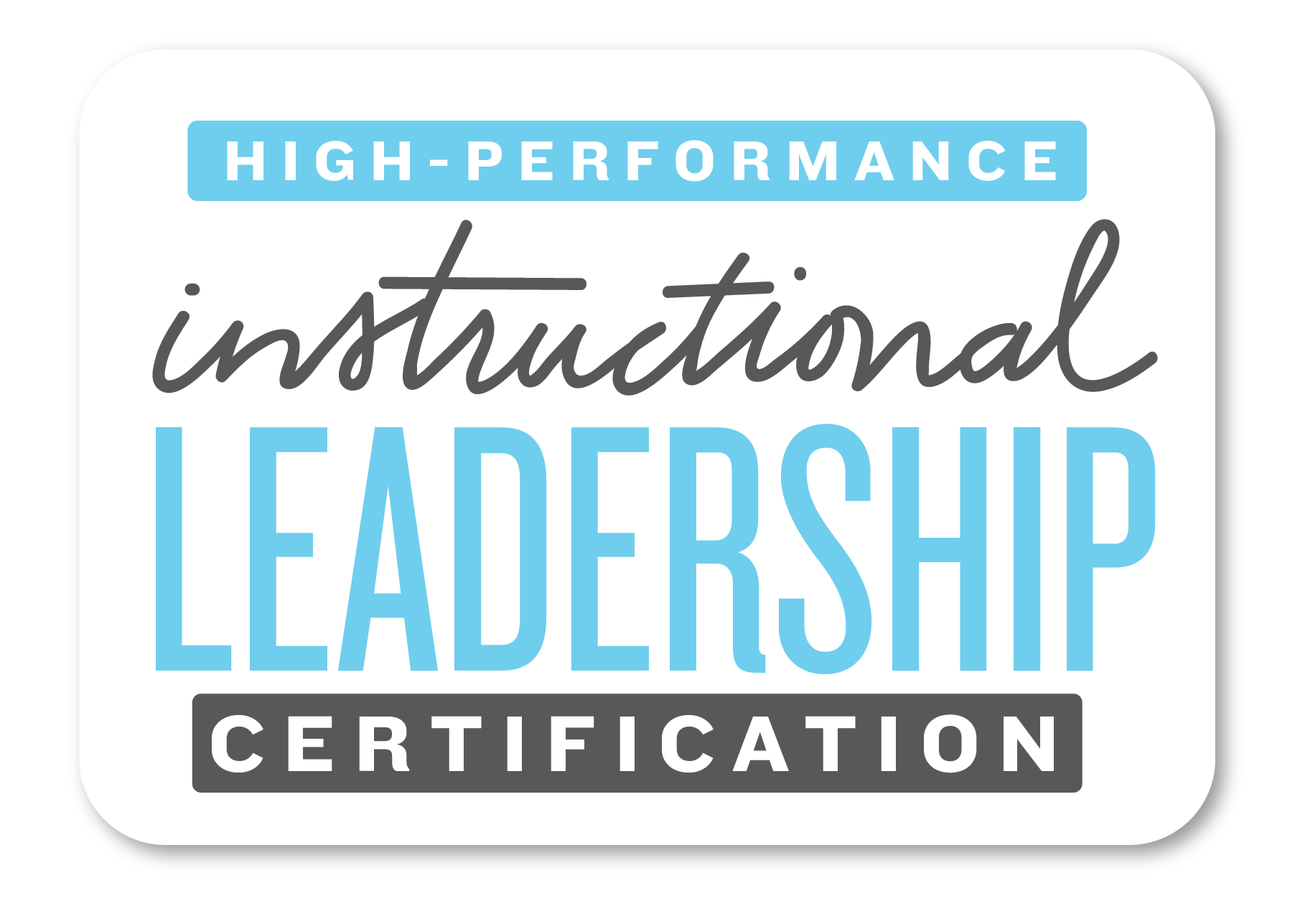
How Can Instructional Leaders
Actually Change Teachers' Practice?
As instructional leaders, we're supposed to provide feedback to teachers, right?
But it's not just an obligation...it's supposed to actually be helpful.
How can we provide feedback that truly makes a difference?
If you've ever wondered...
...you're not alone.
I'm Justin Baeder. When I became a principal at the age of 27, I struggled to provide good feedback.
I'd been a middle school science teacher, but I became an elementary principal.
Literacy? New to me.
Math? I knew the concepts, but not the curriculum.
Kindergarten? Uh-oh...
And even at the middle or high school level, I would have faced the same problem:
As instructional leaders, we can't be experts in everything.
I wanted to take instructional leadership seriously. I wanted my classroom visits to make a difference.
So I did what we're taught to do in graduate school.
I tried to provide every teacher with a "feedback sandwich" consisting of:

Did it work?
At first, it felt great. I'd visit a teacher, find something nice to say, come up with a helpful suggestion, and close with another compliment.
But soon, I started to run into trouble.
I'd observe an outstanding teacher...and struggle to find a suggestion for improvement.
Or I'd write a nice-sounding compliment...but it'd ring hollow.
Or I'd see a lesson that looked like a mess, and not really know where to start with the teacher.
I was doing what I'd been taught, but it felt wrong.
I wanted to provide good feedback, but the "feedback sandwich" wasn't working.
I was frustrated, and if you've felt frustration at this point, you're not alone.
So I decided to try something else...
Instead of "providing feedback," I redefined my goal for classroom visits.
My new goal: simply having a conversation.
Conversations turned out to be lower-stakes and higher-impact than traditional feedback.
In these conversations with teachers, I started to listen more than talk.
And I started to learn far more than I could have anticipated:
And here's what DIDN'T happen...
No one came running to my office demanding their "feedback sandwich."
No one said "Justin, I really need two compliments and a suggestion from you!"
Instead, teachers grew more relaxed and open to talking with me.
I started to have more fun—instead of tough conversations, I was having enjoyable conversations—and most important of all, conversations that impacted teacher practice.
But it wasn't until we adopted a new curriculum that I realized the power of a shared instructional framework.
The Power of a Shared Instructional Framework
Having conversations with teachers was great...usually.
Sometimes, talking with teachers about their practice is fun and rewarding.
But too often, we'd get off track.
I'm sure you've seen it all:
I needed a way to keep conversations focused on improving teaching and learning.
So I started with our state's teacher evaluation criteria.
I thought they'd provide some structure to our conversations.
Rather than talk about anything that came to mind, we'd have a specific focus.
For example, one of the criteria was "Interest in teaching pupils."
Hmm.
We could talk about whether the teacher was demonstrating interest in teaching pupils...but for how long?
It wasn't much to go on.
There was no rubric. No descriptors or indicators. Just the phrase "Interest in teaching pupils."
What did that even mean?
So I was delighted when my district adopted Charlotte Danielson's Framework for Teaching.
The Framework became our new evaluation tool, and its rubrics were much more useful.
Organized into four domains, each with sub-components, the Danielson Framework is very specific.
It also identifies four levels of performance:
Unsatisfactory | Basic | Proficient | Distinguished |
|---|
Still, it was lacking what teachers cared about most: relevance to their subject and grade level's curriculum.
So I started to refer to a few other kinds of resources when visiting classrooms:
The teacher's guide and other curriculum documents became part of my instructional framework, too.
I realized these documents were critical for providing good feedback.
One day, I was observing a math lesson in a great teacher's classroom.
Despite the teacher's skill and experience, the lesson wasn't making any sense to me.
"Why is she only teaching half of this concept?" I wondered.
So I looked in the teacher's guide, and saw how the rest of the unit was structured.
And it made total sense—once I had the full picture.
I almost gave this great teacher terrible feedback—because I didn't know how the unit was structured.
And that's when I realized:
Feedback must relate to the teacher's goals for the lesson, not just our evaluation criteria.
It's not enough to have overall standards for teaching.
For feedback to be helpful, it needs to speak to what the teacher intended to accomplish.
I was starting to gain momentum with high-quality feedback.
And as I continued to visit classrooms and talk with teachers, I found one more type of expectation to include.
It kept coming up over and over again: our school-wide expectations.
For example, we'd done some training on "strategies for accountable talk," and teachers were using the strategies.
They didn't appear in our curriculum, or in our evaluation framework.
But they were a part of daily instruction, so I worked them into my feedback, too.
Together, these three set of expectations comprised our shared instructional framework:
This framework transformed my conversations with teachers.
It kept us on track, and it allowed us to have deep, authentic conversations...conversations that changed practice.
Instead of simply telling teachers what they were doing well—and where they could get better—I could use the language of our framework to dive deep into teachers' thinking and decision-making.
This gave me a much deeper understanding of our approaches to curriculum and instruction, and it gave me the context I needed to write high-quality evaluations.
From Informal Walkthroughs to Airtight Evaluations
Equipped with our instructional framework and a conversational approach, I finally started to enjoy getting into classrooms.
Classroom walkthroughs became a habit—not just something I did occasionally, but a core part of my leadership.
Because I was in classrooms so much, I had plenty of evidence for annual evaluations.
Teacher evaluations are always a lot of work, but they're much easier to write when you can be specific about areas of strength and weakness for each teacher.
When I did only my required formal observations—once or twice a year, for 30-60 minutes—I didn't have much to work with.
You can learn quite a bit from observing a whole lesson...but you can't learn everything about a teacher.
When your evaluation system has 20+ components in 4 domains, and each requires a rating on a 4-point scale...
Gathering enough evidence becomes essential.
Two formal observations per year didn't give me nearly enough evidence.
So when I made daily walkthroughs a core part of my practice, I started to learn much more about my teachers and how they could improve.
But I was worried that my informal visits would be taken the wrong way.
"Is this evaluative?" teachers would ask me. ("Is he out to get me?" is probably what they were really thinking.)
"Well, it's not one of our formal, scheduled observations..." I'd reply. "But the richer a picture I have, the fairer I can be in your final evaluation."
Instead of one or two chances to evaluate each teacher, I now had a dozen or more.
But these walkthroughs were valuable precisely because they weren't focused on evaluation.
In fact, I never gave teachers a rating, or a score on a rubric, or anything evaluative during walkthroughs.
Instead, we focused on conversation.
And in that conversation, I uncovered the thinking behind the teaching I was seeing.
I discovered what each teacher needed to move forward, and of course, writing final evaluations became very easy, because I had so much context about each teacher.
More importantly, though, the pieces all started to fit together, because something unexpected happened.
As I spent more time in classrooms, I thought I'd be letting my "building management" duties slide...
But instead, they got easier.
How could spending more time in classrooms make the rest of my job easier?
In a word, information.
With the information I was gathering in classrooms, I could make better operational decisions that supported instruction.
So instead of having three separate leadership tasks—walkthroughs, evaluations, and running the school—I finally had a system.
It served me well as a principal, and it's been the foundation of my work with instructional leaders at The Principal Center since 2012.
A hallmark of Justin Baeder’s professional development content is its highly practical relevance for school leaders, revealing the benefit of his years as a working principal.
A System for Instructional Leadership
Over the past five years, I've developed the High-Performance Instructional Leadership model into its present form, and the response has been incredible.
More than 10,000 people in 50 countries have participated in the Instructional Leadership Challenge.
I've shared this model at dozens of conferences around the country.
Administrators have taken the Challenge to heart, with many leaders visiting classrooms 500+ times in a single school year.
(One leader, Sam, visited classrooms 1,173 times this past school year.)
The Challenge led to a book:
Now We're Talking!
21 Days to High-Performance
Instructional Leadership

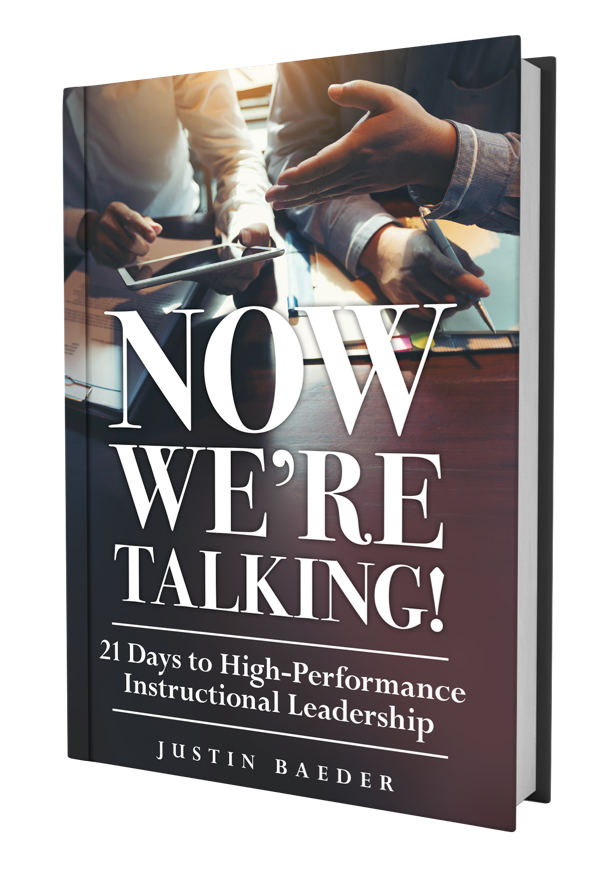
The book gives you the complete model—but a book isn't enough to help you develop the instructional leadership skills that will take your school to the next level.
This is long-term work—work that requires a more intensive level of training and support, over multiple cycles of classroom visits.
If you're ready, I want to help you master the High-Performance Instructional Leadership model, so you can achieve your goals as an instructional leader.
I can't spend the next two months on your campus—I'd have to charge too much, and I'd miss my family too much.
So I've created a self-paced online program to help you master these practices.
The High-Performance Instructional Leadership Certification Program
The High-Performance Instructional Leadership Certification Program has two major components:
1. The course, which is divided into 8 modules (see below)
2. The certification—a rigorous, evidence-based portfolio assessment process, validating your mastery of the essential components of the High-Performance Instructional Leadership model. You can complete the certification at any time after completing the course.
Course Modules

Module Format
What You'll Learn in Each Module
Module 1
The Power of Professional Conversation
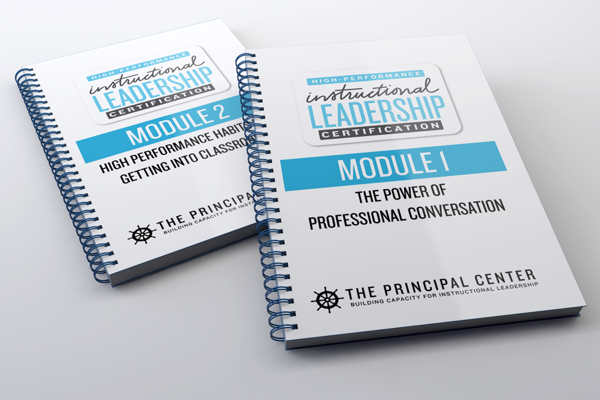
Module 2
High-Performance Habits for Getting Into Classrooms
Module 3
The Classroom Connection: Understanding Instructional Improvement
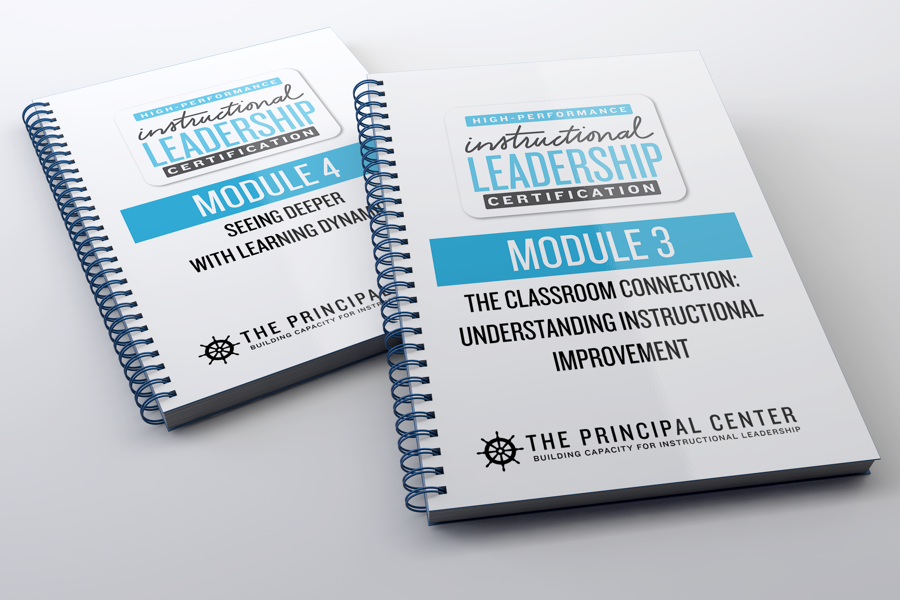
Module 4
Seeing Deeper with Learning Dynamics™
Module 5
The Power of A Shared Instructional Framework
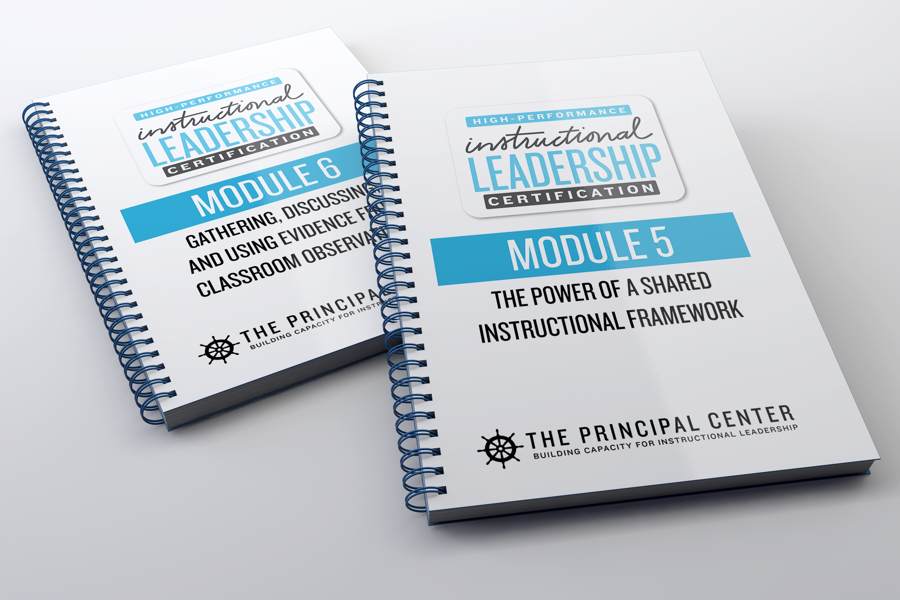
Module 6
Gathering, Discussing, and Using Evidence from Classroom Observations
Module 7
High-Performance Formal Evaluations
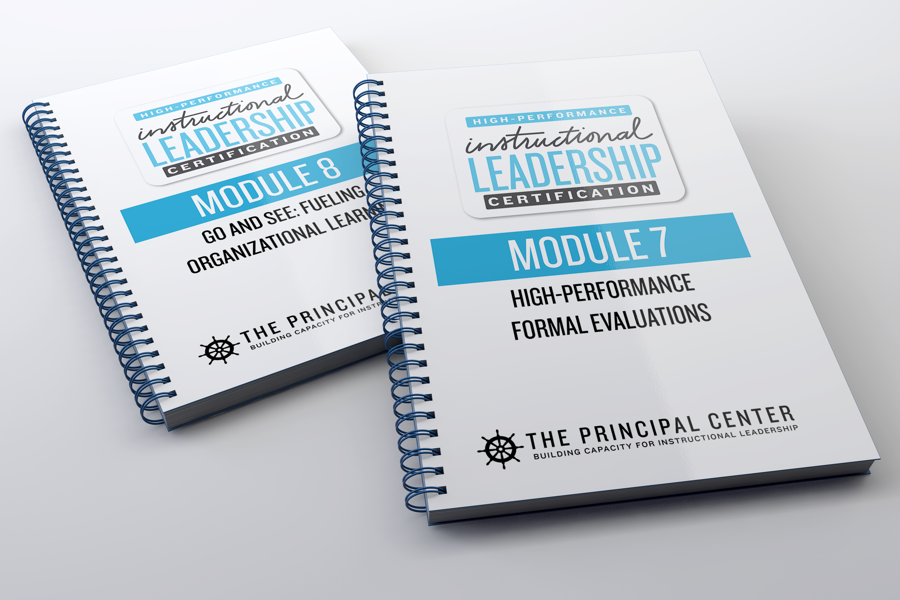
Module 8
Go and See: Fueling Organizational Learning
Joining the Principal Center has been the single best PD decision I have made for myself this year. [The Principal Center] empowers me to approach my work with confidence and a mindset of growth.
Certification Program
The High-Performance Instructional Leadership Certification allows you to demonstrate your ability to provide effective instructional leadership—particularly through evidence-based, framework-linked feedback conversations with teachers.
Register for the certification and you'll receive:
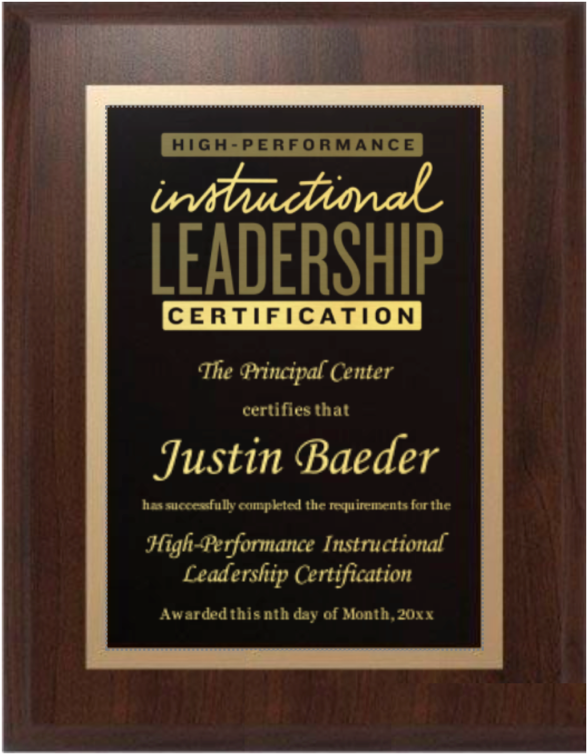
You can register for the certification when joining the course, or add it later.
To receive your certification plaque, you'll complete the following portfolio tasks and submit them for scoring.
Certification Portfolio Tasks
Who Is This Program For?
Current Administrators
Instructional Coaches
Aspiring Administrators
Central Office Leaders
The resources provided by Justin and The Principal Center have supported my growth as an Administrator and Principal. The ideas, concepts, and practices are useful and valuable.
Bonuses
When you enroll in the program, we'll include even more to help you succeed:
1-Year Principal Center Professional Membership
Gain access to our library of on-demand trainings to help you build capacity for instructional leadership—plus two new live webinar trainings each month ($228 value)


Concierge Setup of Repertoire App
Free Copy of Now We're Talking!
You'll receive a signed copy of Now We're Talking! 21 Days to High-Performance Instructional Leadership, by Principal Center Director Justin Baeder.



High-Performance Feedback Flowcharts
You'll receive the High-Performance Feedback Flowcharts: A Playbook for Keeping Conversations on Track PDF guide, designed to streamline your feedback conversations.
100% Tuition Credit for Ascend
If you've been considering our Ascend program, we wanted to make it an easy choice.
Register for the High-Performance Instructional Leadership Certification program, and you'll be able to add Ascend at any time in the future, with 100% of your HPILC course registration fee applied to your Ascend tuition.
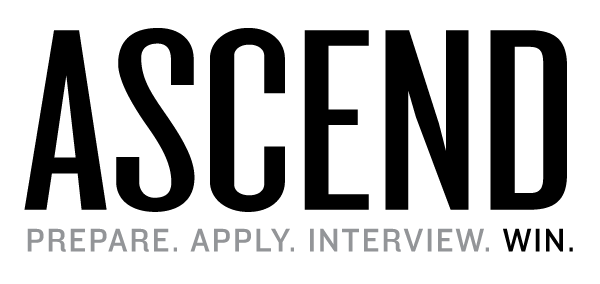
Money-Back Guarantee
The High-Performance Instructional Leadership Certification Program will dramatically strengthen your instructional leadership skills, and allow you to provide highly effective feedback to teachers at all skill levels.
We're fully confident that it's the most powerful professional development for instructional leaders anywhere—but don't take our word for it.
Try the program for yourself, and experience the transformation that it brings to your leadership.
If you're not 100% satisfied with the our program for any reason, contact us within 30 days for a full refund.
